Why is Axiom 5, in the list of Euclid’s axioms, considered a ‘universal truth’? (Note that the question is not about the fifth postulate.)
Axiom 5 states that the whole is greater than the part.
This axiom is known as a universal truth because it holds true in any field, and not just in the field of mathematics.
Let us take two cases: one in the field of mathematics and one other than that.
Case I
Let t represent a whole quantity and only a,b,c are parts of it.
t=a+b+c
Clearly, t will be greater than all of its parts a,b and c.
Therefore, it is rightly said that the whole is greater than the part.
Case II
Let us consider continent Asia. Then, let us consider a country India which belongs to Asia. India is a part of Asia and it can also be observed that Asia is greater than India. That is why we can say that the whole is greater than the part. This is true for anything in any part of the world and is thus a universal truth.
Similar Questions
Consider two ‘postulates’ given below:(i) Given any two distinct points A and B, there exists a third point C which is in between A and B.(ii) There exist at least three points that are not on the same line. Do these postulates contain any undefined terms? Are these postulates consistent? Do they follow from Euclid’s postulates? Explain.
View SolutionGiven the sets A={1,3,5}, B={2,4,6}and C={0,2,4,6,8}, which of the following may be considered as universal set (s) for all the three sets A, B and C (i) {0,1,2,3,4,5,6} (ii) ϕ(iii){0,1,2,3,4,5,6,7,8,9,10}(iv){1,2,3,4,5,6,7,8}
View Solution
Knowledge Check
You Are Where You Say
Research on regional variations in English-language use has not only yielded answers to such life-altering questions a show people in different parts of the United States refer to carbonated beverages (“soda”? “pop”? “coke”?) it also illustrate show technology can change the very nature of research. While traditional, human-intensive data collection has all but disappeared in language studies, the explosion ofsocial media has open edne wave nues for investigation. [1] Perhaps the epitome of traditional methodology is the Dictionary of American Regional English, colloquially known as DARE. [2] Its fifth and final alphabetical volume—ending with “zydeco”— released in 2012, the dictionary represents decade so far duous work. [3] Overa six-year period from 1965 to 1970, university graduate students conducted inter views in morethan a thousand communities across the nation. [4] Their goal was to determine what names people used for such every day object sand concepts as a submarine sandwich.
(a “hero” in New York City but a “dagwood”in many parts of Minnesota, Iow a, and Colorado) and a heavy rainstorm(variously a “gullywasher,” “pour-down,” or “stumpmover”). [5] The work that dictionary founder Frederic G. Cassidy had expected to be finished by 1976 was not,in fact, completed in his life time. [6] The wait did not dampen enthusiasm among scholars. Scholars consider the work a signal achievement in linguistics. Not all research into regional English varieties requires such time, effort, and resources, however. Today’s researchers have foundth at the veritable army of trained volunteer straveling the country conducting face-to- face inter view scan sometimes be replaced by another army the vastarray of individuals volunteering details about their lives— and,in advertently, their language— through social media. Brice Russ of Ohio State University,for example, has employed software to sort through postings on one social media cite in search of particular words and phrases of interest as well as the location from which users are posting. From these data,
he was able, among other things, to confirm regional variations in people's terms for soft drinks. As the map shows. ,“soda” is comm only heard in the middle and western portions of the United States, “pop” is frequently used in many southern states, and “coke”ispre dominant in the north eastern and south west region sbutused else where as well. As interesting as Russ’s findings are, though, they’re true value lies in their reminder that the Internet is not merelya sophisticated tool for collecting data but is also itself a rich source of data
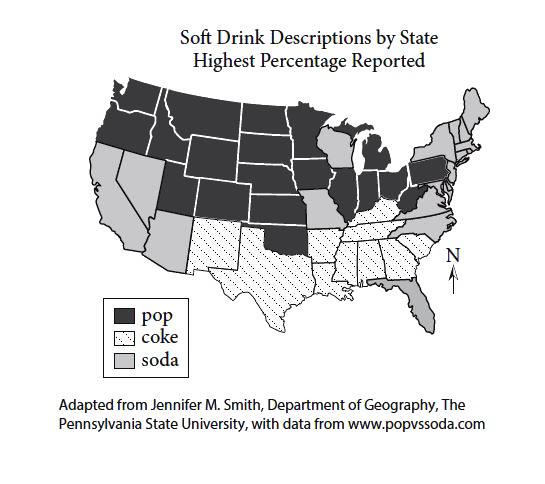
The writer wants to convey an attitudeof genuine interest and to avoid the appearance of mockery. Which choice best accomplishes this goal?ANo ChangeBgalvanizingCintriguingDweirdYou Are Where You Say
Research on regional variations in English-language use has not only yielded answers to such life-altering questions a show people in different parts of the United States refer to carbonated beverages (“soda”? “pop”? “coke”?) it also illustrate show technology can change the very nature of research. While traditional, human-intensive data collection has all but disappeared in language studies, the explosion ofsocial media has open edne wave nues for investigation. [1] Perhaps the epitome of traditional methodology is the Dictionary of American Regional English, colloquially known as DARE. [2] Its fifth and final alphabetical volume—ending with “zydeco”— released in 2012, the dictionary represents decade so far duous work. [3] Overa six-year period from 1965 to 1970, university graduate students conducted inter views in morethan a thousand communities across the nation. [4] Their goal was to determine what names people used for such every day object sand concepts as a submarine sandwich.
(a “hero” in New York City but a “dagwood”in many parts of Minnesota, Iow a, and Colorado) and a heavy rainstorm(variously a “gullywasher,” “pour-down,” or “stumpmover”). [5] The work that dictionary founder Frederic G. Cassidy had expected to be finished by 1976 was not,in fact, completed in his life time. [6] The wait did not dampen enthusiasm among scholars. Scholars consider the work a signal achievement in linguistics. Not all research into regional English varieties requires such time, effort, and resources, however. Today’s researchers have foundth at the veritable army of trained volunteer straveling the country conducting face-to- face inter view scan sometimes be replaced by another army the vastarray of individuals volunteering details about their lives— and,in advertently, their language— through social media. Brice Russ of Ohio State University,for example, has employed software to sort through postings on one social media cite in search of particular words and phrases of interest as well as the location from which users are posting. From these data,
he was able, among other things, to confirm regional variations in people's terms for soft drinks. As the map shows. ,“soda” is comm only heard in the middle and western portions of the United States, “pop” is frequently used in many southern states, and “coke”ispre dominant in the north eastern and south west region sbutused else where as well. As interesting as Russ’s findings are, though, they’re true value lies in their reminder that the Internet is not merelya sophisticated tool for collecting data but is also itself a rich source of data
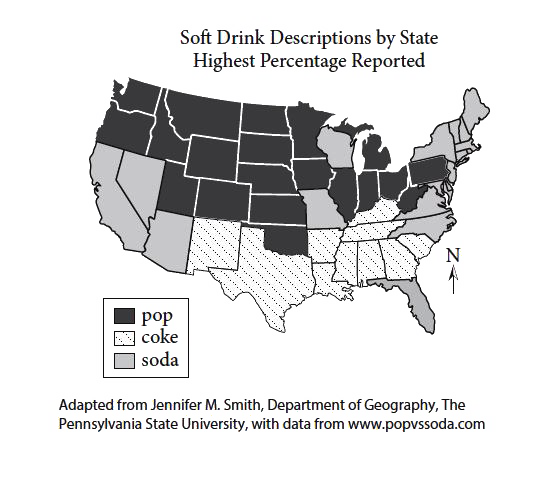
Which choice most effectively concludes the sentence and paragraphANo ChangeBwhere we can earn what terms people use to refer to soft drinks.Ca useful way to stay connected to friends, family, and colleagues.Dhelpful to researchers.You Are Where You Say
Research on regional variations in English-language use has not only yielded answers to such life-altering questions a show people in different parts of the United States refer to carbonated beverages (“soda”? “pop”? “coke”?) it also illustrate show technology can change the very nature of research. While traditional, human-intensive data collection has all but disappeared in language studies, the explosion ofsocial media has open edne wave nues for investigation. [1] Perhaps the epitome of traditional methodology is the Dictionary of American Regional English, colloquially known as DARE. [2] Its fifth and final alphabetical volume—ending with “zydeco”— released in 2012, the dictionary represents decade so far duous work. [3] Overa six-year period from 1965 to 1970, university graduate students conducted inter views in morethan a thousand communities across the nation. [4] Their goal was to determine what names people used for such every day object sand concepts as a submarine sandwich.
(a “hero” in New York City but a “dagwood”in many parts of Minnesota, Iow a, and Colorado) and a heavy rainstorm(variously a “gullywasher,” “pour-down,” or “stumpmover”). [5] The work that dictionary founder Frederic G. Cassidy had expected to be finished by 1976 was not,in fact, completed in his life time. [6] The wait did not dampen enthusiasm among scholars. Scholars consider the work a signal achievement in linguistics. Not all research into regional English varieties requires such time, effort, and resources, however. Today’s researchers have foundth at the veritable army of trained volunteer straveling the country conducting face-to- face inter view scan sometimes be replaced by another army the vastarray of individuals volunteering details about their lives— and,in advertently, their language— through social media. Brice Russ of Ohio State University,for example, has employed software to sort through postings on one social media cite in search of particular words and phrases of interest as well as the location from which users are posting. From these data,
he was able, among other things, to confirm regional variations in people's terms for soft drinks. As the map shows. ,“soda” is comm only heard in the middle and western portions of the United States, “pop” is frequently used in many southern states, and “coke”ispre dominant in the north eastern and south west region sbutused else where as well. As interesting as Russ’s findings are, though, they’re true value lies in their reminder that the Internet is not merelya sophisticated tool for collecting data but is also itself a rich source of data
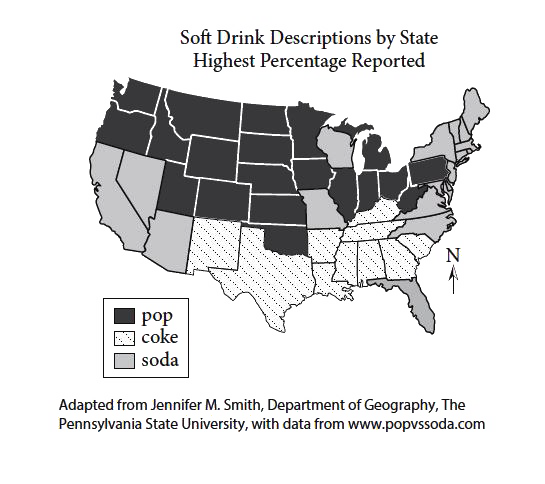 ANo ChangeBand also illustratesCbut also illustratesDillustrating
ANo ChangeBand also illustratesCbut also illustratesDillustrating
(a) A certain mass of gas initially at (1L,5atm,300K) is expanded reversible and isothermally to final volume of 5L, calculate the work done by the gas and heat supplied in this process to the gas.
(b) Now, if the gas is released to initial position by compressing it using an external constant pressure of 5 atm. Find work done on the gas in this process and heat rejected by gas
(c ) In the above two processes, what is the net gained by surroundings ?
[Note: From above question see that surrounding has done extra work on the system but system has returned that work in the form of heat to surrounding and work is considered on organized form of energy while heat as an unorganised form hence in the above process, there must be net increment in randomness of universe which be called Entropy, soon]
View SolutionYou Are Where You Say
Research on regional variations in English-language use has not only yielded answers to such life-altering questions a show people in different parts of the United States refer to carbonated beverages (“soda”? “pop”? “coke”?) it also illustrate show technology can change the very nature of research. While traditional, human-intensive data collection has all but disappeared in language studies, the explosion ofsocial media has open edne wave nues for investigation. [1] Perhaps the epitome of traditional methodology is the Dictionary of American Regional English, colloquially known as DARE. [2] Its fifth and final alphabetical volume—ending with “zydeco”— released in 2012, the dictionary represents decade so far duous work. [3] Overa six-year period from 1965 to 1970, university graduate students conducted inter views in morethan a thousand communities across the nation. [4] Their goal was to determine what names people used for such every day object sand concepts as a submarine sandwich.
(a “hero” in New York City but a “dagwood”in many parts of Minnesota, Iow a, and Colorado) and a heavy rainstorm(variously a “gullywasher,” “pour-down,” or “stumpmover”). [5] The work that dictionary founder Frederic G. Cassidy had expected to be finished by 1976 was not,in fact, completed in his life time. [6] The wait did not dampen enthusiasm among scholars. Scholars consider the work a signal achievement in linguistics. Not all research into regional English varieties requires such time, effort, and resources, however. Today’s researchers have foundth at the veritable army of trained volunteer straveling the country conducting face-to- face inter view scan sometimes be replaced by another army the vastarray of individuals volunteering details about their lives— and,in advertently, their language— through social media. Brice Russ of Ohio State University,for example, has employed software to sort through postings on one social media cite in search of particular words and phrases of interest as well as the location from which users are posting. From these data,
he was able, among other things, to confirm regional variations in people's terms for soft drinks. As the map shows. ,“soda” is comm only heard in the middle and western portions of the United States, “pop” is frequently used in many southern states, and “coke”ispre dominant in the north eastern and south west region sbutused else where as well. As interesting as Russ’s findings are, though, they’re true value lies in their reminder that the Internet is not merelya sophisticated tool for collecting data but is also itself a rich source of data
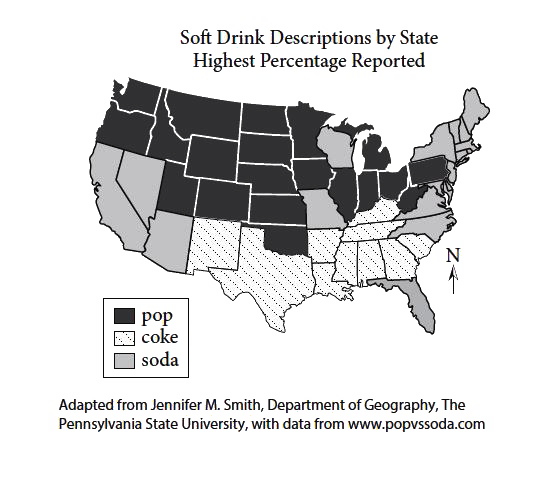
Which choice most effectively sets up the contrast in the sentence and is consistent with the information in the rest of the passage?
View SolutionYou Are Where You Say
Research on regional variations in English-language use has not only yielded answers to such life-altering questions a show people in different parts of the United States refer to carbonated beverages (“soda”? “pop”? “coke”?) it also illustrate show technology can change the very nature of research. While traditional, human-intensive data collection has all but disappeared in language studies, the explosion ofsocial media has open edne wave nues for investigation. [1] Perhaps the epitome of traditional methodology is the Dictionary of American Regional English, colloquially known as DARE. [2] Its fifth and final alphabetical volume—ending with “zydeco”— released in 2012, the dictionary represents decade so far duous work. [3] Overa six-year period from 1965 to 1970, university graduate students conducted inter views in morethan a thousand communities across the nation. [4] Their goal was to determine what names people used for such every day object sand concepts as a submarine sandwich.
(a “hero” in New York City but a “dagwood”in many parts of Minnesota, Iow a, and Colorado) and a heavy rainstorm(variously a “gullywasher,” “pour-down,” or “stumpmover”). [5] The work that dictionary founder Frederic G. Cassidy had expected to be finished by 1976 was not,in fact, completed in his life time. [6] The wait did not dampen enthusiasm among scholars. Scholars consider the work a signal achievement in linguistics. Not all research into regional English varieties requires such time, effort, and resources, however. Today’s researchers have foundth at the veritable army of trained volunteer straveling the country conducting face-to- face inter view scan sometimes be replaced by another army the vastarray of individuals volunteering details about their lives— and,in advertently, their language— through social media. Brice Russ of Ohio State University,for example, has employed software to sort through postings on one social media cite in search of particular words and phrases of interest as well as the location from which users are posting. From these data,
he was able, among other things, to confirm regional variations in people's terms for soft drinks. As the map shows. ,“soda” is comm only heard in the middle and western portions of the United States, “pop” is frequently used in many southern states, and “coke”ispre dominant in the north eastern and south west region sbutused else where as well. As interesting as Russ’s findings are, though, they’re true value lies in their reminder that the Internet is not merelya sophisticated tool for collecting data but is also itself a rich source of data
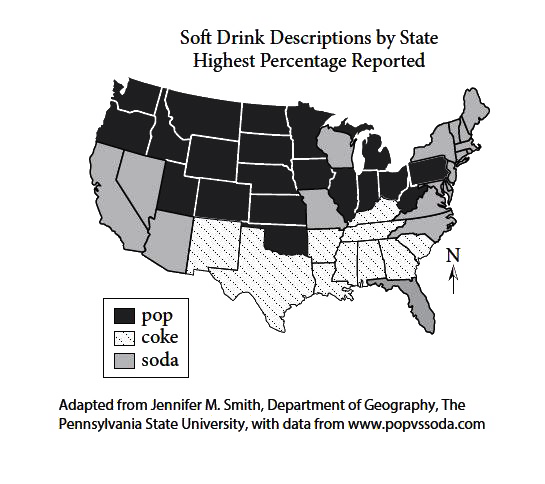
View SolutionYou Are Where You Say
Research on regional variations in English-language use has not only yielded answers to such life-altering questions a show people in different parts of the United States refer to carbonated beverages (“soda”? “pop”? “coke”?) it also illustrate show technology can change the very nature of research. While traditional, human-intensive data collection has all but disappeared in language studies, the explosion ofsocial media has open edne wave nues for investigation. [1] Perhaps the epitome of traditional methodology is the Dictionary of American Regional English, colloquially known as DARE. [2] Its fifth and final alphabetical volume—ending with “zydeco”— released in 2012, the dictionary represents decade so far duous work. [3] Overa six-year period from 1965 to 1970, university graduate students conducted inter views in morethan a thousand communities across the nation. [4] Their goal was to determine what names people used for such every day object sand concepts as a submarine sandwich.
(a “hero” in New York City but a “dagwood”in many parts of Minnesota, Iow a, and Colorado) and a heavy rainstorm(variously a “gullywasher,” “pour-down,” or “stumpmover”). [5] The work that dictionary founder Frederic G. Cassidy had expected to be finished by 1976 was not,in fact, completed in his life time. [6] The wait did not dampen enthusiasm among scholars. Scholars consider the work a signal achievement in linguistics. Not all research into regional English varieties requires such time, effort, and resources, however. Today’s researchers have foundth at the veritable army of trained volunteer straveling the country conducting face-to- face inter view scan sometimes be replaced by another army the vastarray of individuals volunteering details about their lives— and,in advertently, their language— through social media. Brice Russ of Ohio State University,for example, has employed software to sort through postings on one social media cite in search of particular words and phrases of interest as well as the location from which users are posting. From these data,
he was able, among other things, to confirm regional variations in people's terms for soft drinks. As the map shows. ,“soda” is comm only heard in the middle and western portions of the United States, “pop” is frequently used in many southern states, and “coke”ispre dominant in the north eastern and south west region sbutused else where as well. As interesting as Russ’s findings are, though, they’re true value lies in their reminder that the Internet is not merelya sophisticated tool for collecting data but is also itself a rich source of data
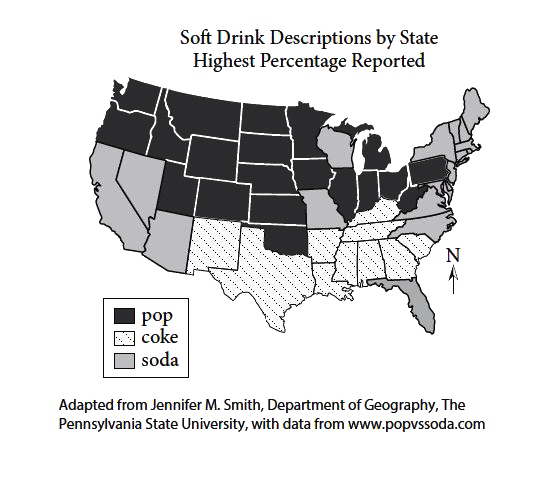
View SolutionYou Are Where You Say
Research on regional variations in English-language use has not only yielded answers to such life-altering questions a show people in different parts of the United States refer to carbonated beverages (“soda”? “pop”? “coke”?) it also illustrate show technology can change the very nature of research. While traditional, human-intensive data collection has all but disappeared in language studies, the explosion ofsocial media has open edne wave nues for investigation. [1] Perhaps the epitome of traditional methodology is the Dictionary of American Regional English, colloquially known as DARE. [2] Its fifth and final alphabetical volume—ending with “zydeco”— released in 2012, the dictionary represents decade so far duous work. [3] Overa six-year period from 1965 to 1970, university graduate students conducted inter views in morethan a thousand communities across the nation. [4] Their goal was to determine what names people used for such every day object sand concepts as a submarine sandwich.
(a “hero” in New York City but a “dagwood”in many parts of Minnesota, Iow a, and Colorado) and a heavy rainstorm(variously a “gullywasher,” “pour-down,” or “stumpmover”). [5] The work that dictionary founder Frederic G. Cassidy had expected to be finished by 1976 was not,in fact, completed in his life time. [6] The wait did not dampen enthusiasm among scholars. Scholars consider the work a signal achievement in linguistics. Not all research into regional English varieties requires such time, effort, and resources, however. Today’s researchers have foundth at the veritable army of trained volunteer straveling the country conducting face-to- face inter view scan sometimes be replaced by another army the vastarray of individuals volunteering details about their lives— and,in advertently, their language— through social media. Brice Russ of Ohio State University,for example, has employed software to sort through postings on one social media cite in search of particular words and phrases of interest as well as the location from which users are posting. From these data,
he was able, among other things, to confirm regional variations in people's terms for soft drinks. As the map shows. ,“soda” is comm only heard in the middle and western portions of the United States, “pop” is frequently used in many southern states, and “coke”ispre dominant in the north eastern and south west region sbutused else where as well. As interesting as Russ’s findings are, though, they’re true value lies in their reminder that the Internet is not merelya sophisticated tool for collecting data but is also itself a rich source of data
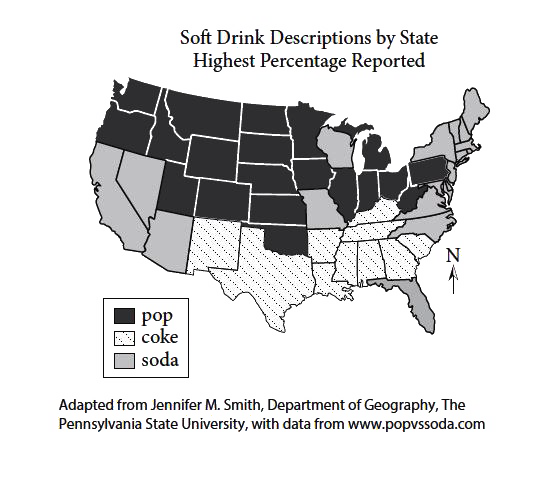
View Solution
